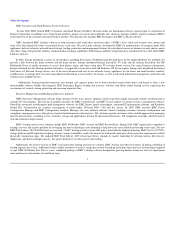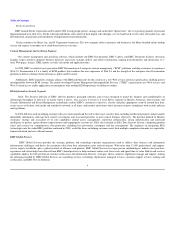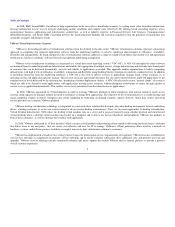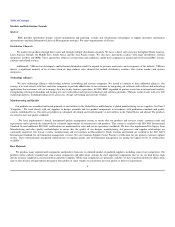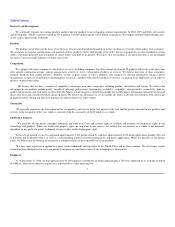EMC 2008 Annual Report Download - page 17
Download and view the complete annual report
Please find page 17 of the 2008 EMC annual report below. You can navigate through the pages in the report by either clicking on the pages listed below, or by using the keyword search tool below to find specific information within the annual report.
Table of Contents
received in the last weeks and days of each quarter may be limited, which could materially adversely affect quarterly revenues and earnings.
In addition, our revenues in any quarter are substantially dependent on orders booked and shipped in that quarter and our backlog at any particular time is
not necessarily indicative of future sales levels. This is because:
we assemble our products on the basis of our forecast of near-term demand and maintain inventory in advance of receipt of firm orders from
customers;
we generally ship products shortly after receipt of the order; and
customers may generally reschedule or cancel orders with little or no penalty.
Loss of infrastructure, due to factors such as an information systems failure, loss of public utilities or extreme weather conditions, could impact our
ability to ship products in a timely manner. Delays in product shipping or an unexpected decline in revenues without a corresponding and timely slowdown in
expenses, could intensify the impact of these factors on our business, results of operations and financial condition.
In addition, unanticipated changes in our customers' purchasing behaviors such as customers taking longer to negotiate and complete their purchases or
making smaller, incremental purchases based on their current needs, also make the prediction of revenues, earnings and working capital for each financial
period difficult and uncertain and increase the risk of unanticipated variations in our quarterly results and financial condition.
Risks associated with our distribution channels may materially adversely affect our financial results.
In addition to our direct sales force, we have agreements in place with many distributors, systems integrators, resellers and original equipment
manufacturers to market and sell our products and services. We may, from time to time, derive a significant percentage of our revenues from such distribution
channels. For 2008, Dell Inc., one of our channel partners, accounted for 11.5% of our revenues. Our financial results could be materially adversely affected if
our contracts with channel partners were terminated, if our relationship with channel partners were to deteriorate, if the financial condition of our channel
partners were to weaken, if our channel partners are not able to timely and effectively implement their planned actions or if the level of demand for our
channel partners' products and services decreases. In addition, as our market opportunities change, we may have an increased reliance on channel partners,
which may negatively impact our gross margins. There can be no assurance that we will be successful in maintaining or expanding these channels. If we are
not successful, we may lose sales opportunities, customers and market share. Furthermore, the partial reliance on channel partners may materially reduce the
visibility to our management of potential customers and demand for products and services, thereby making it more difficult to accurately forecast such
demand. In addition, there can be no assurance that our channel partners will not develop, market or sell products or services or acquire other companies that
develop, market or sell products or services in competition with us in the future.
In addition, as we focus on new market opportunities and additional customers through our various distribution channels, including small-to-medium
sized businesses, we may be required to provide different levels of service and support than we typically provided in the past. We may have difficulty
managing directly or indirectly through our channels these different service and support requirements and may be required to incur substantial costs to provide
such services which may adversely affect our business, results of operations or financial condition.
Due to the international nature of our business, changes in foreign conditions or other factors could impair our international operations, future
revenue or financial condition.
A substantial portion of our revenues is derived from sales outside the United States. In addition, a substantial portion of our products is manufactured
outside of the United States. Accordingly, our future results could be materially adversely affected by a variety of factors, including changes in foreign
currency exchange rates, changes in a specific country's or region's political or economic conditions, trade restrictions, import or export licensing
requirements, the overlap of different tax structures or changes in international tax laws, changes in regulatory requirements, compliance with a variety of
foreign laws and regulations and longer payment cycles in certain countries. In addition, we hold a significant portion of our cash and investments in our
international subsidiaries. Potential regulations could impact our ability to transfer the cash and investments to the United States. Additionally, should we
desire to repatriate cash, we may incur a significant tax obligation.
13
•
•
•


